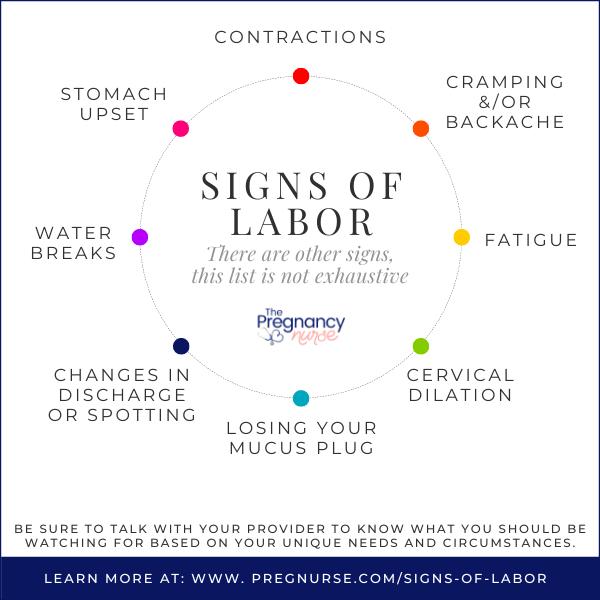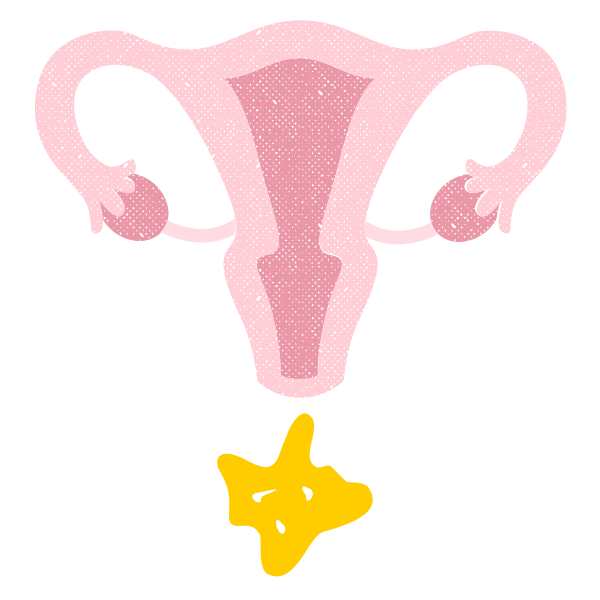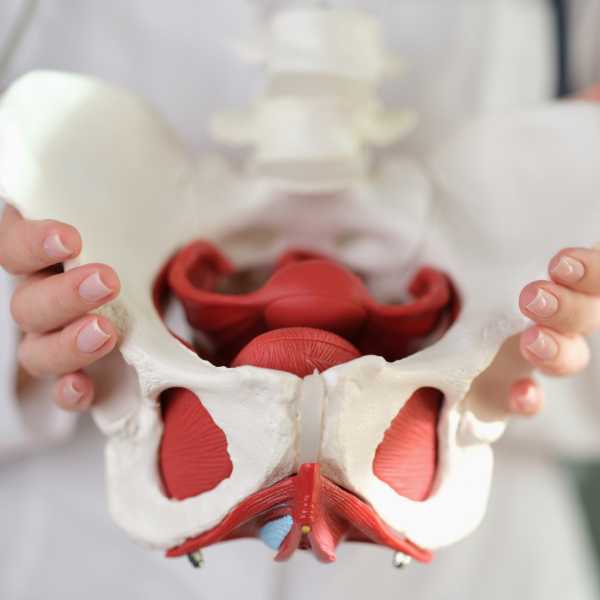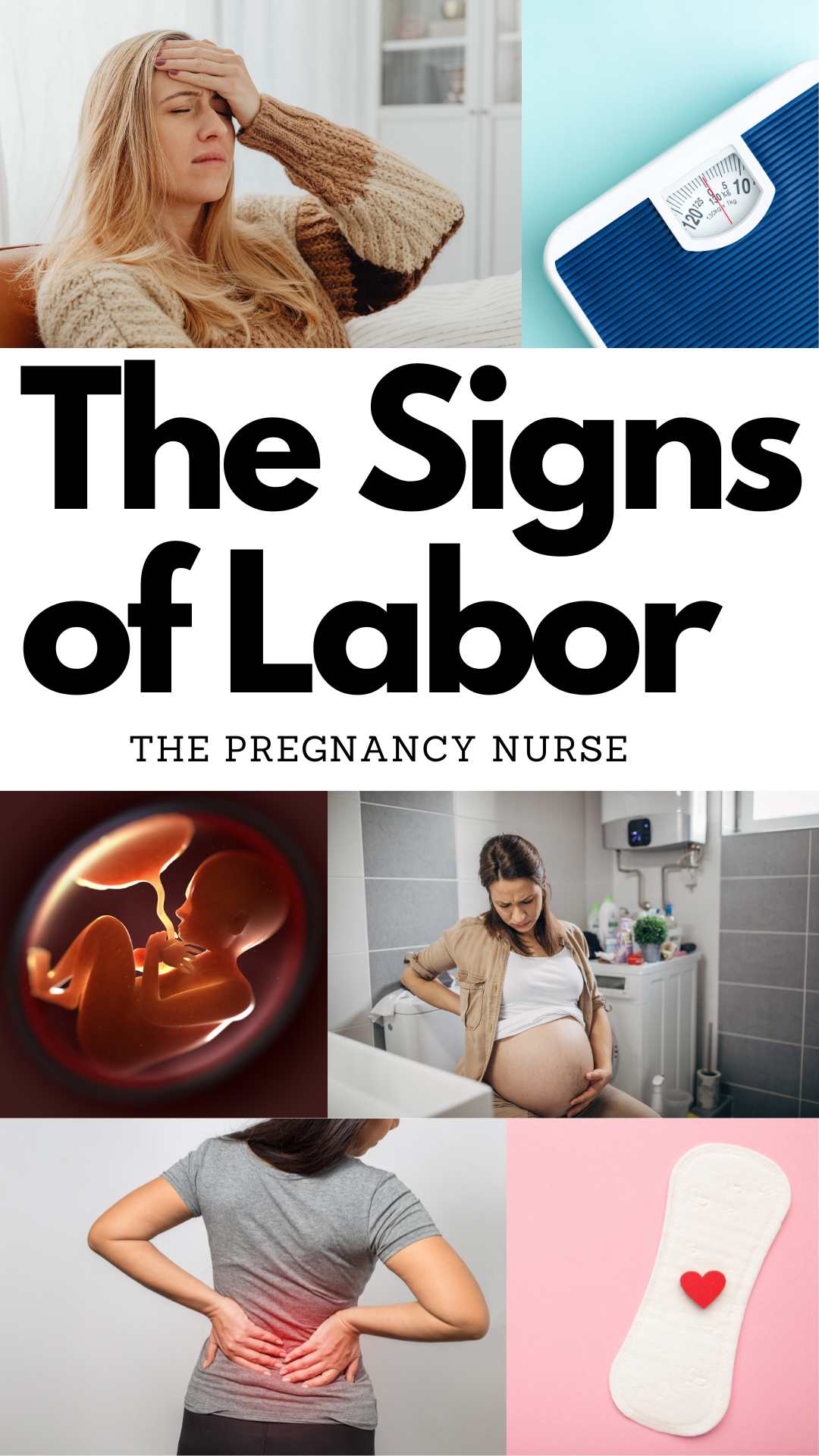Knowing if you’re going into labor will dominate a good part of your time as you get closer to your due date. This article is going to talk about the different signs you’re watching for, and what it may feel like. You’ll also know when you should call your doctor to make sure that you’re still OK. Every person is different, and you should definitely call your provider if you have any questions about what you’re feeling.

Labor can be REALLY confusing (especially when you’re experiencing it yourself, with all the pain and hormones). I want to be clear on that, but I hope you find this article helpful to know what to watch for. BUT, this is truly the easy way to get prepared. Come join me!
What this article talks about? (click on an area to jump ahead)
This (or any article on The Pregnancy Nurse) should be taken as medical advice, this purely educational. Please talk with your health care provider about your specific needs and circumstances, if you have any questions about if something you are experiencing is OK, please call your provider.
What are the Signs of Labor?

This post is going in depth into the different symptoms of labor that you might experience. If you’d like to see some videos where I explain it more to you check out labor made easy.
These aren’t going to be in any particular order, and it is important to talk with your provider about any symptoms that are problematic for you in particular. While many of these show that labor and birth will be soon, some of these signs and symptoms can come and go in the days (and weeks) before labor.
Always assess your labor symptoms right now, less so on what has happened, or what you think might happen. Predicting the future is hard!
Ok, let’s get going!
Cramping

Cramping is often one of the early signs of labor. Most women identify this as the cramps involved with PMS or with their periods. Most often it is a non-specific ache in your lower abdomen (sometimes also in your back). It most often comes in waves and may come for an hour and then go away.
Cramping can also be caused by being your feet too much, over-exerting yourself, dehydration or sometimes even a urinary tract infection.
Cramping can be a sign of premature labour (we’re going to talk more about that in this post) and I have an article that specifically talks about cramping at 24 weeks of pregnancy.
Most often cramping is something people experience in early labor, although it can be hard to know when you’ve stepped over the line to “contraction” pain (because it just feels like more severe cramping).
Beyond those strong menstrual cramps, you may also get stomach cramps with diarrhea (more info on that coming up) — which can make it hard to figure out which is which.
Many women experience muscle cramps during their pregnancy as well. If you are having them frequently, talk with your doctor about anything you can do for them. Any new and significant pains should be something you mention to your provider. It’s important to know what’s OK and what is a problem — I recommend this class to learn the basics.
Backache

Backache can be a sign of labor (usually lower back pain). It goes along with cramping — and it can often depend on the position of the baby as to where you feel the cramps or the contractions.
Many pregnant women feel low back pain for much of their third trimester due to changes in posture and body mechanics as you have a giant bump in front of your body. So it can be hard at the end of pregnancy to decide which it is…
Often you can use a heating pad to help your back — just remember to not use it on your belly, use it only for about 20 minutes and on a lower setting so you don’t raise your core body temperature.
Contractions

Contractions are probably one of the most common signs of labor, and the one most people talk about.
Uterine contractions are just like a muscle contraction (because your uterus is made of muscle tissue). If you flexed your arm every 3 minutes for hours on end, it would also get painful.
However, regular contractions are also a coordinated effort to evacuate the baby from your uterus. Meaning it is pushing the baby’s head towards the birth canal.
Uterus contractions can be tricky, and many people aren’t sure what to feel for. The hospital monitors contractions with a device called a toco (tocodynameter). Sometimes it picks up contractions people aren’t even feeling.
Some people just feel their belly tighten, and then relax, Some people mix it up with fetal movement (because that tightening feeling is very similar to fetal movement — and we’re going talk more about fetal movement too).
Contractions can feel really confusing, but I talk a LOT about it in here, and in just a few hours we can have you totally prepared for labor!
Contractions in general just feel like stronger menstrual cramps. Most people say they feel very similar to a very bad bout of food poisoning also. The annoying thing about strong contractions is that you really will know them once you have them. But, until then it can seem nebulous.

Fatigue

Fatigue that comes-on abruptly at the end of pregnancy can be a sign of labor. They believe that it is your body preparing to do a LOT of work, and it wants you to rest before it does it (which makes sense).
This can be tricky though, because most women at 39 weeks just feel tired all the time. They are essentially doing the work of two humans, and carrying around a lot of extra blood volume and weight in order to do that.
The key would be it coming on abruptly, that’s what you’d want to watch for. Generalized fatigue is just a sign you’re very, very pregnant and ready to have a baby soon.
And, not all pregnant women get this sign (or differentiate it from the regular fatigue they’re feeling).
You’ll find that a lot of the signs of labor may also just be things you experience towards the end of pregnancy. Since women report them before labor, often they are given as signs of labor, so that’s something to keep in mind.
Cervical Dilation

Dilation happens as the baby’s head pushes down on the cervix (which is basically the end of the cervix — like how the rectum is the end of your intestines). Normally the cervix is very thick and closed, but as the baby pushes down on it, it starts to thin out and open.
I like to liken it to pushing your head through a tight turtleneck sweater. You know that the knit will stretch and thin out to let your head through.
Dilation is figured out by a medical professional, I don’t recommend you try to check your cervix yourself, as it takes a professional who has checked a lot of cervixes to know what yours means.
When they check your cervix (with a vaginal exam) they learn a lot of things:
- Dilation – a measurement of the opening of the cervix from one edge of the cervix to the other — measured with people’s fingers
- Effacement – how thick your cervix is (usually anything les than 50% effaced is pretty thick — the 50% refers to how much cervix is gone — so 90% is a very thin cervix)
- Station – how high or low the baby is in your pelvis. This is measured agains your ischial spines (your sit bones)
- Consistency – How the cervix feels — is it hard or soft? If your cervix is hard like rubber it is less likely to open up.
A cervix often opens a little as the baby gets heavier and gravity pushes them against it. Many people will find out that they are 1 cm at an early vaginal exam. Some doctors offer a vaginal exam at 36 weeks, but you can always refuse. It is unlikely to give you much information because if you are not having current contractions you can stay 1 cm for a while.
The bigger question is if your cervix is actively dilating — meaning if we check you an hour later, does it feel more open, softer, thinnner? Most often you need frequent contractions to move past those early centimeters.
Remember that there are a few stages of labor:
1 – Latent Labor or Early Labor — 0 to 5’ish centimeters — most often the contractions aren’t as frequent and regular, and your cervix isn’t actively changing
2 – Active Labor — When your cervix is actively opening, contractions are more regular and baby is descending into the birth canal
3 – Pushing — Once you hit 10 cm you can join in with the contractions and push the baby into the world.
4 – Delivery of baby and placenta — that one explains itself.
Your cervical exam basically tells what stage you are in.
Losing your Mucus Plug

The mucus plug is a “cork” of people at the end of your cervix. It is made of mucus, skin cells, sometimes blood and other items found in the vagina. And yes, it is as gross as it sounds. This thick plug of mucus is meant to protect baby while it is growing from anything that is in the vagina.
As the cervix softens, and opens the mucus plug sometimes comes out. I like to compare it to an upside down bottle of wine that has been heated and the top begins to soften and open up. It would be natural with gravity for that cork to fall out.
The mucus plug does not always come out, and sometimes people don’t notice when it does. Sometimes it just dissolves into pieces in the vagina and comes out slowly in chunks. There is no reason to keep it or take a photo to show your provider.
We don’t need evidence of the mucus plug being gone to call you “in labor”.
In general, the loss of the mucus plug does show that the cervix is somewhat dilated or softened. So, when you lose it it does show that things are starting to happen. If you’re prior to 36 weeks and you think you’ve lost your mucus plug you should call your provider because we don’t want your cervix to open that early.
Losing your mucus plug is more of a sign that labor is approaching, maybe in the next week or so.
This is different than mucus-y discharge. The mucus plug tends to be thicker, chunkier and you can tell that it’s been around for a while (vs vaginal mucus which is replaced frequently by the vaginal wall).
Changes in Discharge

As your uterus starts to contract, and your cervix softens, your vaginal discharge may change.
Some of that can be parts of the mucus plug. But also the vaginal wall increases discharge as blood flow to that area increases. Many pregnant people find themselves wearing a pad or pantiliner the last few weeks of their pregnancy because of it.
Your discharge can increase, but it it seems much more watery and of a larger amount, it is possible that your amniotic sac has ruptured. If you think that is a possibility please contact your provider.
You may find some blood in your discharge. This blood can be dark brown (that’s older blood that’s been around for a while) or bright red blood (that’s newer). Some people even call it orange discharge if it is mixed with mucus.
However, when the discharge is just blood that’s…..
Spotting

Spotting is small amounts of bleeding, normally brighter red than dark brown, although some people describe their discharge as pink.
Now, earlier in pregnancy bleeding would normally be a cause to call the doctor right away or go into labor and delivery, but past about 36 weeks, small amounts of spotting (less than the size of a quarter) can just show that you are dilating and can be a sign of labor.
Amounts of blood that are more than spotting are called “bloody show” and can show that the cervix is actively dilating. A good percentage of women have that during labor (although some don’t).
If you are having bleeding that is causing you any concern (bloody show isn’t something you should handle on your own) I recommend you call your provider. Bleeding is definitely not something to mess around with, and most providers have someone on for them 24/7 to answer questions like this (it may not be your regular doctor, just someone who is trained to answer calls).
Increased Fetal Movement

Some people report increased fetal movement before labor. Is is important that you do your kick counts starting in your third trimester. This way you are very attune to what is normal for your baby, vs what isn’t normal. Fetal movement is your best indicator of baby’s well being and it is important that you’re aware of it.
The idea behind this is that baby is likely trying to find their best position to slide into the birth canal. If you were trying to get into a tight tube you might twist and turn a lot as you squeeze into it. Same idea.
Also, as the uterus is so cramped at the end of pregnancy you feel every move that baby makes, which can feel like increased movement. Whatever you do, keep doing those kick counts to make sure baby is moving well!
Baby Lowers / Pelvic Pressure

As baby heads into the birth canal you may begin to feel more pelvic pressure, or some people call it more of a pelvic fullness.
This may also make you need to pee all the time. You may also suddenly find you can take deeper breaths as baby isn’t in your lung space as much. It’s sort of annoying that we have to sacrifice our bladder space in order to get lung space, but that’s how the laws of physics work.
Some people have the baby drop right before delivery, and many have it happen in the weeks before birth. You may hear other people say “you’re carrying so high” — oh “your baby is so low” and that is due to where baby is in your pelvis (or their own ignorance).
This pressure, along with the hormones that help your pelvis to relax can make it hard to walk due to the pelvic pain. This can cause symphysis pubis dysfunction (or separation).
Nausea, Vomiting Diarrhea

Your gastro-intestinal system (stomach and intestines) sometimes gets the sign to “clear-out”. Which results in some stomach upset.
Meaning, you may have diarrhea, nausea, and sometimes even vomiting involved.
Your intestines run right near the birth canal, and it makes sense that you’d want to clear out that space before the baby comes through that area. I’ve noticed that people that go into labor naturally (and often have these symptoms) avoid pooping at delivery because that system is already cleared out.
It also often makes you not want to eat much while you are in labor. Your partner can encourage you to keep eating small snacks. I’m a big fan of ones that balance carbs and protein. I actually have a bonus video in the Bump to Bassinet bundle that talks about nutrition during labor that can be helpful too!
Headache

Pregnant people may experience many headaches during their pregnancy. It is really important that if you have a headache that will not go away with Tylenol, food and water that you call your provider. It could be a sign of preeclampsia.
However, a lot of women report having a headache before labor begins.
Many people report a “generalized malaise” before going into labor. That means that overall they just don’t feel well overall. Often that comes with a light headache. If you have a pounding headache that is different.
Preeclampisa is definitely a concern as you get close to your due date. Beyond headaches, other symptoms include blurry vision, sometimes a pain in your ribs (usually on the right), high blood pressure and protein in your urine at a prenatal check-up. If you have those symptoms your doctor will normally order lab work to check to see if it is an issue.
Often mild headaches are caused from dehydration, so I always recommend to drink a couple of large glasses of water. This has a bonus of helping you to feel better overall (and possibly stopping any false labor) in addition to helping your headache.
Drinking water throughout labor is so important. One of the best part is that it keeps your veins easy to get an IV in the hospital. People who haven’t drunk water during labor make it hard to get the IV in (and tend to feel more miserable).
Weight Loss

Often, people lose weight as they get close to labor. Although, it’s not really a SIGN of labor.
This weight loss is found in many women’s charts as they get close to their due date, and it happens for a number of reasons:
There is less amniotic fluid – the baby puts out less urine (most amniotic fluid is baby pee), and the baby also swallows more amniotic fluid in the womb as it gets closer living outside the womb. It is also possible that you’re slowly leaking amniotic fluid (if you think that is an issue please contact your provider).
You may be moving more in the weeks before labor– be it nesting your nesting instinct with it’s sudden burst of energy, or moving more now that preterm labor isn’t an issue, you may be moving more, which will decrease your weight.
Your Water Breaks
This is actually a sign that labor has begun, but it can be confusing. Your amniotic sac may tear a bit at the top, and in that case you only leak a little now and then — vs if it breaks at the bottom, you may get a big gush.
The rupture of your amniotic sac (we call it SROM in the hospital) may come with contractions, or with out them. You may start to feel the contractions more strongly once it breaks.
Only about 15% of women in the US have their water break outside the hospital setting, so while you may imagine this always happens it usually does not. However, I still recommend that people keep some towels or a puppy pad (affiliate link) in their car and at work just in case.
If your water breaks it truly is the start of labor. This is because once that bag of water is broken it can allow bacteria in the birth canal to get to the baby, and significantly raises your risk of infection. Providers want baby to be out sooner rather than later once you have rupture of membranes (that’s what we call it when your bag of fluid breaks).
Either way, amniotic fluid continues to come out now and then as baby pees and it collects. You may notice it more when you change position, pee, laugh or cough.
If you have ANY questions about if your water broke, be sure to talk with your provider. There is a test we can do in the hospital to make sure it is your water that is broken (because sometimes you’re not sure if you peed or if your water broke).
If you’re worried about fluids hurting textiles around your home or car check out these. I think they’re a great option for your bed, couch or car (especially the car). Plus SUPER handy after baby is born too! Fluids aren’t stopping any time soon!
While this isn’t ALL the signs of labor it’s a good number of them. Learn more about the signs of labor in here.
What is the Difference Between True Labor Contractions and False Labor?
I made a handy chart that the difference between false labor and actual labor, and might help you tell the difference:
| True Labor | False Labor | |
| Contractions | Continue (no matter what you’re doing), get more intense, closer together, lasting longer | May stop with rest or activity, aren’t at regular intervals, may stop/start. |
| Pain | Get more and more painful | Can also be quite painful, but don’t continue an don’t stay in a pattern (or get more painful) |
| Location | May start in your belly or your back, but then starts to radiate through your whole torso. | Tends to be in your back or your front, but doesn’t radiate as much (but can be very painful). |
| Other symptoms | Tends to come with other symptoms as noted in this article | Often is just one or two symptoms. |
| Definition | Actively opens your cervix | Does not cause reliable cervical change. |
I want to emphasize that in the beginning “true labor” and “false labor” can feel VERY similar and VERY painful. It is more about the coordinated effort of your uterus vs just tension of the muscle. Both of them feel like “real contractions”.
False labor has a few nicknames. Braxton Hicks Contractions, “practice contractions” are a couple of the names it’s known by.
If you’re not sure which it is, I always recommend drinking two giant glasses of water, eating some food (balance carbs and proteins) and laying down for a bit. If you’re hydrated and contractions are continuing through that, it may be the real thing, but it also may take some time for those contractions to get really regular.
But, as it says — the main difference is that it causes cervical change, and moving baby into the birth canal.
Have you checked a birth class off your to do list✅? I have a few I recommend:
❤️ Best class for couples {per BabyList}
👩💻 Best class available on demand
⚡ Best class JUST for pain management
👶 Best Postpartum-Only Prep
❤️🧡💛💚💙💜 My favorite class is here.
Now is the time to get started!
Things to Do to Progress Labor?
You may be reading this wishing you could get into labor to stop being pregnant, and I don’t blame you. Those last few weeks of pregnancy are miserable. I get it.
I do have a whole guide on my best tips to go into labor that you can check-out.
But, the three best ones are:
Let the Oxytocin Flow
Oxytocin is the love hormone, and it flows best when your brain and your body are relaxed. If you’re worried about delivery, or crumpled up in the fetal position it doesn’t flow as well. I find that positive affirmations can help me feel more positive in general.
If you’re nervous about delivery it truly can stop your body from going into labor, so make sure you get prepared and feel more relaxed about delivery (I recommend this).
Labor happens when your brain, your body and the baby agree it’s time to get it out — and letting oxytocin flow is so important with that!
Movement
Changing position every 30 minutes or so can really help baby find their best way out. A lot of people do figure 8’s on a yoga ball, or do some curb walking, but really just shifting those hips to help baby rotate is a win.
Your birth partner can be a great asset reminding you to change position (and help you up) every 30 minutes or so when not asleep (make sure they know to not wake you up if you’re asleep).

Still not sure what you want to do, a lot of people swear by the Miles Circuit. I often tell people to try those movements and then see what feels good and keep doing those.
Except when you’re….
Sleeping
Sleep is important, and it helps your body relax and feel better, and you’ll need your energy for labor. When you’re sleeping just relax and enjoy it. Your body needs lots of rest as you’re keeping two people alive. And yes, you CAN go into labor while you’re sleeping!
I only recommend the movement changes when you’re not sleeping, and when you’re sleeping relax (pillows between your hips may even help baby find a good spot, and will also help with hip pain too).
I’m not kidding that you having any fear or anxiety about labor can stop it — just join me in here!
Have you checked a birth class off your to do list✅? I have a few I recommend:
❤️ Best class for couples {per BabyList}
👩💻 Best class available on demand
⚡ Best class JUST for pain management
👶 Best Postpartum-Only Prep
❤️🧡💛💚💙💜 My favorite class is here.
Now is the time to get started!
When Is It OK to Go Into Labor?
In general, providers don’t really want you to go into labor before 37 weeks. For a long time it was 36 weeks, but they’d really prefer 37 weeks, because babies seem to thrive better when they are past that age of gestation (their systems are just more ready to live in the world).
Prior to about 35 weeks (depends on the provider) they will likely try to stop your labor using medications. Ask your provider at your next appointment what labor signs are OK for you, and when you should call them or head into labor and delivery.
Another good question is to ask “how many contractions are OK in an hour.” I’ve heard many of them say no more than 6 contractions in an hour — but check with your provider.
If you have ANY questions as to if you’re going into preterm labor, call your provider.
Symptoms of Preterm Labor
Preterm labor symptoms are the same as labor, it is just starting earlier than it should. And, unlike regular labor, you need to be more cognizant of the early symptoms because you want to stop it early if you can.
Once you’re safely able to deliver, you can ignore more of those early signs because they may be frequent until baby is finally born.
What To Do If you’re in Labor?
If you’re past the point when your provider thinks it’s safe to be in labor your best bet is to:
- Hydrate
- Eat small meals that balance carbs and proteins
- Listen to your body
- Make a note of how far contractions are apart
- Make note of any of the other symptoms
How to count contractions?
Contractions are tracked from the beginning of one contraction to the beginning of the next.
The duration of the contraction is how long they last for you.
When your provider asks, you’ll say something like — they are 4 minutes apart and last about 30 seconds (insert the numbers you have tracked).
Contractions can be tracked in a variety of ways:
- Just keep track in your brain (or your partner’s brain) as to about how far apart they are
- Pencil and paper
- The notes app on your phone
- There are other apps that can help you count easily.
In general, I don’t recommend you really start counting how far apart they are until you’ve had about six in an hour — so about 10 minutes apart.
Before that, I prefer to ignore it because it’s better to sleep, keep doing movements that feel good and just try to live your life.
Contractions often come and go, they may be regular for an hour, but then stop. It’s really annoying. for sure. We talk WAY more about them (and make it so easy) in here.
When the Hospital Will Admit You?
Many people wonder when the hospital will admit them, and they don’t want to go to the hospital and be sent home. It is important that you are honest with your care team about what you are experiencing, so you can be sure you’re in the right place for what’s going on.
First off, there is nothing wrong with being sent home. You know that you and the baby are safe and that things are OK — and you can always come back later. This happens VERY frequently in the hospital and we, as a staff, do want to make sure you’re OK and we can help you know more what to feel and what to think about before coming back next time.
Secondly, ask your provider about how far apart your contractions are before you come in. I know a lot of people give a “magic equation” towards knowing when to go to the hospital but it REALLY varies on:
- What number of baby it is (first baby is sometimes slower)
- Any other previous obstetrical history (like previous uterine or cervical surgery)
- Any issues with this pregnancy (including GBS, placental issues or growth issues with the baby)
- How far the hospital is from your home (and traffic, parking etc can play into it).
Signs of labor can be scary, especially if it’s your first pregnancy (and especially if you’re feeling unprepared). Recognizing the signs and what to do when they occur is the most important thing you can do to ensure a safe and successful delivery. F
or moms who’ve already had a baby… your first labor may have had specific signs, it may be different with every pregnancy (many signs depend on the baby’s position in the womb).
From changes in the baby’s movement to contractions, water breaking, and bloody show, there are multiple indications that it’s time to call your doctor or midwife and start getting ready for your new arrival. It is important that you learn the signs of labor so you know what to watch for.
Keep an eye out for these indicators, be prepared with a bag for the hospital, and rest as much as possible. While labor can seem like the “end” of pregnancy the reality is it’s just the beginning with your new baby. Make sure to be ready and enjoy the transition from pregnancy to parenthood.
And, make sure you’re feeling prepared for birth. Come join me in The Online Prenatal Class for Couples where in just a few hours we can help you feel prepared. It really ISN’T too late to get your prenatal class in!
Maybe you’re like Jess, and you think you’ll just read articles and get prepared…. but here’s what she had to say:
“This class was great! I took it in my 38th week – I had found her articles online and decided to just bite the bullet and take the online class. Very grateful I did. Was very detailed and informational. Would recommend 100%!“
Read More Reviews Here!
And, if you’re not quite sure you’re ready for that whole thing, check out my free prenatal class. It’s your first step toward getting in the driver’s seat of your birth.









 When Does Your Stomach Start to Get Hard When Pregnant
When Does Your Stomach Start to Get Hard When Pregnant

Thank you for your dedication to informing mommas! Your Facebook videos and articles have been an asset, to me as I’m 39 weeks, in my first pregnancy. I’ve thoroughly enjoyed taking in the information, with the simplistic ways you unpack it, truly spoken with experience and passion!
Awh, I really appreciate this comment, and for you learning about your pregnancy. It’s never too late to get a prenatal class in. 🙂